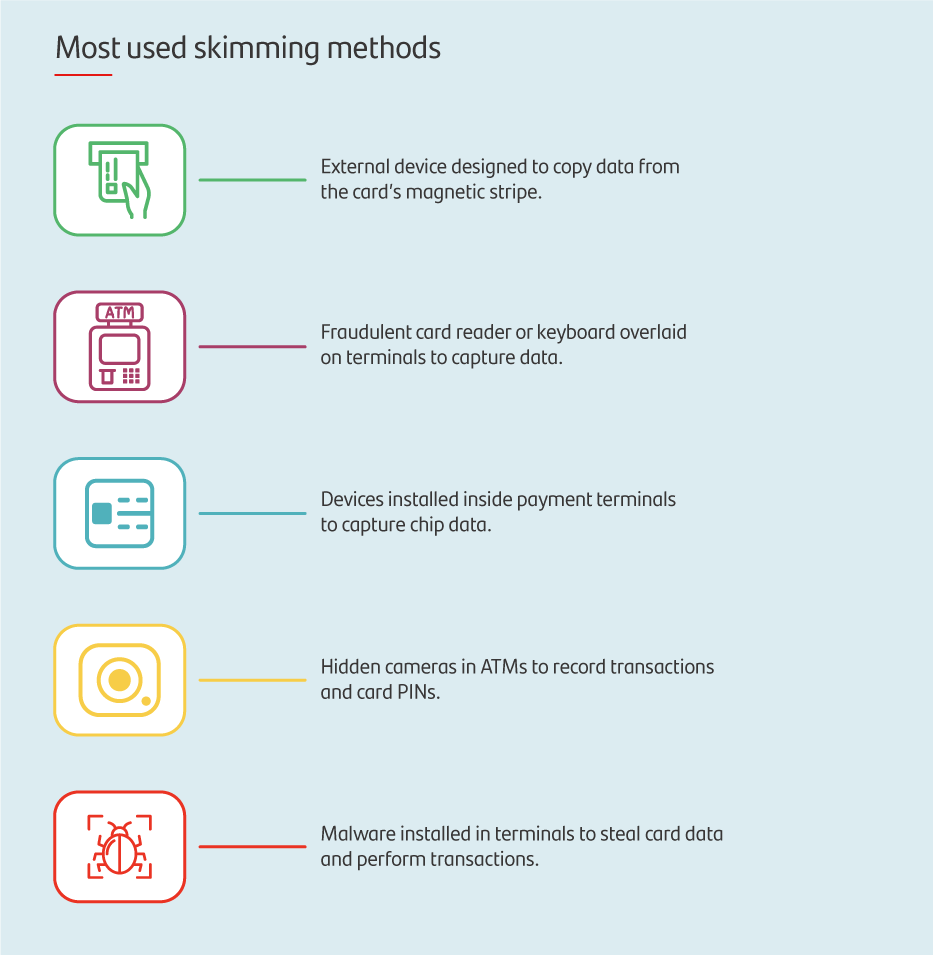Skimming: What is it and how to protect yourself against it?


Paying groceries at the supermarket, dinner at a restaurant, withdrawing cash from the ATM... Your bank cards undoubtedly play an important role in how you manage your personal finances. That’s why it’s important to understand how to use them properly and avoid falling victim to illegal practices like skimming.
Although it’s becoming increasingly common to pay through electronic wallets or contactless methods by means of mobile phones, smart bracelets or watches, the reality is that credit cards and debit cards are one of the most used options when making payments. Both in physical stores and online.
One of the characteristics of bank cards is that, in addition to the data printed on the card itself –name, card number, expiry date or CVV code (card verification value) – this information is also stored in the magnetic stripe and the chip. In fact, there is a criminal practice designed to retrieve such customer payment details and transfer it to a fake card, or directly use it for fraudulent transactions, known as “skimming”.
As the word “skim” means “to read quickly”, criminals use various devices, known as skimmers, to steal data without the victim even realising it. This is usually carried out when making transactions at an ATM or paying at a point-of-sale (POS) terminal that has been tampered with beforehand.

Once criminals have obtained the bank card details, they can make purchases, hire services or withdraw money, among other transactions. They also can sell the information on the black market for a third party to carry out the fraud. These fraudsters also on several occasions make small purchases to avoid easy detection. This method is known as carding and, if you want to learn more about how it works, you can read about it in this Openbank article.

What is e-skimming?
It is a variation of the traditional form of skimming that captures information from online payment methods instead of stealing data from physical cards. In this case, cybercriminals take advantage of security flaws in e-commerce platforms, use malware or trick victims with techniques, such as phishing, to gain access to data.
How to protect yourself against skimming
Without a doubt, learning about the different types of skimming is a good start. That way you can be alert and know how to identify anything abnormal that may occur when you make transactions with your bank cards. The following tips will help you better protect yourself against this type of crime:
When you go to perform transactions at the ATM or to pay at a restaurant, supermarket or any other shop, the most important thing is that you can always see where your card is inserted. In this way, you can avoid it being used on a fraudulent device. If you’re the one handling the card, even better.
Never share your card’s secret number (also known as the PIN) with anyone, and never write it down or save it in your phone, as it can fall into malicious hands. You can also always cover the keyboard with your other hand when entering your PIN at the ATM or POS to prevent anyone from seeing it.
Take a moment to look for foreign objects on the ATM or payment terminal, such as overlaid keyboards or slots. Also check that there are no signs that the device has been modified and that no parts of it are loose, appear to have been tampered with or contain traces of glue, for example.
If there is a poorly lit ATM or payment point, try to find another one, as criminals take advantage of these scenarios to use their fraudulent devices. Always choose those that are in good condition and make you feel secure.
If your digital bank allows it, you can access your app to turn your card on or off, as well as activate or deactivate contactless payment options or online purchases, and limit withdrawals or use outside your country. In this way, you will have more control over how and when you use it.
One way to keep up to date with all your card’s transactions is through notifications on your mobile phone. This way, in the event of fraudulent transactions, you can react more quickly to block them and contact your bank and the authorities.
Verify that the transactions reflected on your statement are consistent with your card use. This will allow you to identify whether there have been any unauthorised charges or cash withdrawals.
Any other measures you can implement to keep your bank card information safe will mean greater security for your transactions. When it comes to protecting yourself and your money, every step counts to avoid falling victim to fraud such as skimming.







